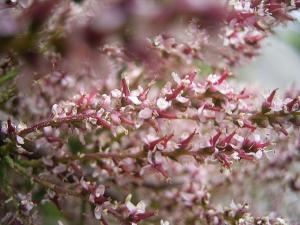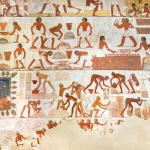Exodus 16:14-15, 21, 31 (RSV) And when the dew had gone up, there was on the face of the wilderness a fine, flake-like thing, fine as hoarfrost on the ground. When the people of Israel saw it, they said to one another, “What is it?” For they did not know what it was. And Moses said to them, “It is the bread which the LORD has given you to eat. . . . when the sun grew hot, it melted. . . . it was like coriander seed, white, and the taste of it was like wafers made with honey.
Numbers 11:7-9 Now the manna was like coriander seed, and its appearance like that of bdellium. The people went about and gathered it, and ground it in mills or beat it in mortars, and boiled it in pots, and made cakes of it; and the taste of it was like the taste of cakes baked with oil. When the dew fell upon the camp in the night, the manna fell with it.
Egyptologist James K. Hoffmeier noted (1),
When Robinson visited St. Catherine’s Monastery in 1838, he learned that the monks gathered what they called manna and that it was highly valued. . . . The American explorer recounts the following:
In accordance with a former promise, the old man likewise put into our hands a small quantity of the manna of the peninsula, famous at least as being the successor of the Israelitish manna, though not to be regarded as the same substance. . . . It is found in the form of shining drops on the twigs and branches . . . of the Turfa, Tamarix Gallic mannifera of Ehrenberg, from which it exudes in consequence of the puncture of an insect of the coccus kind, Coccus manniparus of the same naturalist. . . . It has the appearance of gum, is of sweetish taste, and melts when exposed to the sun or to a fire. The Arabs consider it a great delicacy, and pilgrims prize it highly. (2)
F. S. Bodenheimer (3) noted that this phenomenon happens in June and July, and that he himself at observed it in a 1927 visit to the Sinai Peninsula. Moreover, he argued that the wandering Hebrews would have arrived in the area where the tamarask manna occurs, which Hoffmeier believes is in line with “chronological data provided by the Torah.” (4) Bodenheimer also learned that the Kurds in northern Iraq collect thousands of pounds of this substance every year, which is evidence of the volume of food that would have been required to feed 20,000 or so Hebrews.
As I have stated all along in speculating about these natural explanations: I’m only throwing them out as possibilities or theories (not taking a stand one way or another). I don’t deny the possibility of miracles from God at any time, to the slightest degree. God can use both supernatural and natural means to accomplish his goals.
The Plants For A Future site lists the Tamarix gallica plant and notes, “A manna is produced by the plants in response to insect damage to the stems. It is sweet and mucilaginous. There is some confusion over whether the manna is produced by the plant, or whether it is an exudation from the insects. The insects in question live in the deserts around Israel, . . .” (5)
Encyclopedia Britannica confirms this information,
An edible white honeylike substance known as manna forms drops on the stem of salt cedars, or French tamarisk trees (Tamarix gallica). A scale insect that feeds on tamarisks also secretes honeydew (a sweet by-product of digestion) known as manna. (6)
A site from an entomologist agrees:
This tree was once quite common in the Sinai desert – not sure of its status now – and it is thought to be the origin of the term ‘manna from heaven’ in the bible. The tamarisk manna scale, Trabutina mannipara, produces large quantities of honeydew which solidify in a thick sugary exudate on the leaves. . . . perhaps the insect only occurs in the Sinai? The mealybug was still present there in 1988 . . . (7)
One possibly fatal deficiency in this possible explanation of manna are the biblical statements: “Six days you shall gather it; but on the seventh day, which is a sabbath, there will be none” (Exod. 16:26); “And the people of Israel ate the manna forty years” (Exod. 16:35). This implies (at least prima facie) a continual diet, day-by-day (two day’s worth collected on Friday for the Sabbath: 16:29) for the entire forty-year period, as opposed to manna being available only in June and July. Moreover, only a day’s portion was to be collected (16:19), and in fact it “bred worms and became foul” after a day (16:20), so God didn’t permit them to store it for months. It seems to be a partial but incomplete “fit.” But there is at least one vigorous counter-reply to this objection. Lutheran theologian E. W. Hengstenburg (1802-1869) writes,
According to the commonly received opinion, the manna (apart from the quails, which were only granted transiently) must have been, during the whole forty years of the sojourn in the wilderness, the only food of the Israelites, and consequently imparted to them uninterruptedly, and always in equal abundance. . . . But . . . In Exod. 16:35, it is only said that the eating of the manna was carried on through the whole forty years, by which language interruptions are not excluded. The statement of quantity in Exod. 16:16 refers only to the first time. Of the quantity afterwards nothing is said, and nothing in this passage forbids our supposing that it varied according to the variety of the situations and the wants of the Israelites. . . .
The positive evidence that the Israelites in the wilderness were not merely dependent on the manna for their sustenance, but had other resources at command, we shall first of all adduce from intimations in the Pentateuch itself. . . . this wilderness, according to the accounts of the Pentateuch itself, was the abode of various tribes, to whom the advantage of the natural resources which it presented, furnished support—the Ishmaelites according to Gen. 21:22; 25:18, the Amalekites, the Midianites who, as the history of Moses shows, fed their flocks in the neighbourhood of Mount Sinai.
The same resources which these tribes enjoyed, must have been at the command of the Israelites. Moreover, the Israelites brought numerous herds and flocks with them out of Egypt; compare Exod. 12:38; 17:3, which they would not have done if the wilderness had furnished no sustenance for them. That these possessions of cattle were still existing in the later times of their march, such passages will show as Exod. 34:3, “Neither let the flocks and herds feed before that Mount,” Num. 20:19, where Israel says to Edom, “We will go by the highway; and if I and my cattle drink of thy water, then will I pay for it,” &c.; and Num. 32 where Reuben and Gad, the tribes who probably in Egypt remained most faithful to the nomadic life of their progenitors, found their suit for assigning to them the land beyond Jordan on their large possessions of cattle. . . . In one place at least such productions are expressly mentioned, in Exod. 15:17, where we are told that at Elim there were seventy palm-trees. . . . Therefore it was expressly enjoined them on their march along the eastern border of Edom, Deut. 2:6-7, “Ye shall buy meat of them, for money that ye may eat; and ye shall also buy water of them that ye may drink.” . . .
But thus much is certain; let all the natural resources be brought into account which the wilderness presents, and to this add that in that climate the need of food is proportionably very small; . . . yet there must have been times and places in which the maintenance of such an immense multitude of men necessarily required extraordinary divine aid, if the people were not to perish. That the narrative records such aid, does not take from it the character of credibility, but rather establishes it, especially since what is extraordinary here, as in the wonders and signs in Egypt is closely connected with the ordinary. (8)
Bible scholar Albert Barnes concurs with regard to the “forty years”:
This does not necessarily imply that the Israelites were fed exclusively on manna, or that the supply was continuous during forty years: but that whenever it might be needed, owing to the total or partial failure of other food, it was given until they entered the promised land. They had numerous flocks and herds, which were not slaughtered (see Numbers 11:22 [RSV: “Shall flocks and herds be slaughtered for them, to suffice them? Or shall all the fish of the sea be gathered together for them, to suffice them?”], but which gave them milk, cheese and of course a limited supply of flesh: nor is there any reason to suppose that during a considerable part of that time they may not have cultivated some spots of fertile ground in the wilderness. We may assume, as in most cases of miracle, that the supernatural supply was commensurate with their actual necessity. The manna was not withheld in fact until the Israelites had passed the Jordan. (9)
But Barnes makes a differentiation between natural and supernatural manna:
These directions show that the manna thus given differed essentially from the natural product. Here [Exod. 16:23] and in Numbers 11:8 it is treated in a way which shows that it had the property of grain, could be ground in a mortar, baked and boiled. Ordinary manna is used as honey, it cannot be ground, and it melts when exposed to a moderate heat, forming a substance like barley sugar, called “manna tabulata.” In Persia it is boiled with water and brought to the consistency of honey. The Arabs also boil the leaves to which it adheres, and the manna thus dissolved floats on the water as a glutinous or oily substance. It is obvious that these accounts are inapplicable to the manna from heaven, which had the characteristics and nutritive properties of bread. (10)
I conclude for myself, then (readers may decide as they wish) that manna in the Bible appears to refer to both a natural substance and a supernatural one. It seems to be a case of a clever application by God of analogy or “types and shadows”.
FOOTNOTES
1) James K. Hoffmeier, Ancient Israel in Sinai: The Evidence for the Authenticity of the Wilderness Tradition (Oxford University Press, 2005), 172.
2) Edward Robinson, Biblical Researches in Palestine and the Adjacent Regions (Boston: Croker and Brewster, 1841), I: 170.
3) F. S. Bodenheimer, “The Manna of Sinai,” Biblical Archaeologist 10, no. 1 (1947): 76, 78, 80
4) Hoffmeier, 172.
5) “Tamarix gallica – L.,” Plants For A Future. https://pfaf.org/user/Plant.aspx?LatinName=Tamarix+gallica.
6) “Manna: plant product,” Encyclopedia Britannica, https://www.britannica.com/topic/manna-plant-product.
7) Ray Cannon, “Tamarisk: the manna tree,” Ray Cannon’s nature notes, May 18, 2015. https://rcannon992.com/2015/05/18/tamarisk-the-manna-tree/.
8) Ernest Wilhelm. Hengstenburg, Dissertation on the history and prophecies of Balaam (translated by J. E. Ryland, T & T Clark, 1848). https://books.google.com/books?id=sDxVAAAAcAAJ&dq=Turfa,+Tamarix+Gallica+mannifera,+manna&source=gbs_navlinks_s; 565-569.
9) Albert Barnes, Notes on the Bible (London: Blackie and Son, 1834); on Exodus 16:35. https://biblehub.com/commentaries/barnes/exodus/16.htm.
10) Ibid., on Exodus 16:23.
***
Practical Matters: Perhaps some of my 4,200+ free online articles (the most comprehensive “one-stop” Catholic apologetics site) or fifty-one books have helped you (by God’s grace) to decide to become Catholic or to return to the Church, or better understand some doctrines and why we believe them.
Or you may believe my work is worthy to support for the purpose of apologetics and evangelism in general. If so, please seriously consider a much-needed financial contribution. I’m always in need of more funds: especially monthly support. “The laborer is worthy of his wages” (1 Tim 5:18, NKJV). 1 December 2021 was my 20th anniversary as a full-time Catholic apologist, and February 2022 marked the 25th anniversary of my blog.
PayPal donations are the easiest: just send to my email address: [email protected]. You’ll see the term “Catholic Used Book Service”, which is my old side-business. To learn about the different methods of contributing, including 100% tax deduction, etc., see my page: About Catholic Apologist Dave Armstrong / Donation Information. Thanks a million from the bottom of my heart!
***
Photo credit: TeunSpaans (5-25-05): photo (from The Hague, Netherlands) shows a flowered branch of Tamarix gallica. [Wikimedia Commons / Creative Commons Attribution-Share Alike 3.0 Unported license]
***
Summary: There is a plausible explanation concerning a natural form of manna in the Bible, but it can’t explain everything, & there is likely also a supernatural manifestation.














